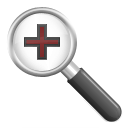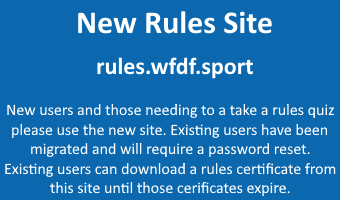18. Infractions and Violations
-
18.1. Marking Infractions:

-
18.1.1. Marking infractions include the following:
-
18.1.1.1. “Fast Count” – the marker:
-
18.1.1.1.1. starts or continues the stall count illegally,
-
18.1.1.1.2. does not start or restart the stall count with the word “Stalling”,
-
18.1.1.1.3. counts in less than one second intervals,
-
18.1.1.1.4. does not correctly reduce or reset the stall count when required, or
-
18.1.1.1.5. does not start the stall count from the correct number.

-
18.1.1.2. “Straddle” – a line between a defensive player’s feet comes within one disc diameter of the thrower’s pivot point.

-
18.1.1.3. “Disc Space” – any part of a defensive player is less than one disc diameter away from the torso of the thrower. However, if this situation is caused solely by movement of the thrower, it is not an infraction.

-
18.1.1.4. “Wrapping” – a line between a defensive player’s hands or arms comes within one disc diameter of the thrower’s torso, or any part of the defensive player’s body is above the thrower’s pivot point. However, if this situation is caused solely by movement of the thrower, it is not an
infraction. 

-
18.1.1.5. "Double Team" –a defensive player other than the marker is within three (3) metres of the thrower's pivot point without also guarding another offensive player. However, merely running across this area is not a double team.

-
18.1.1.6. “Vision” - a defensive player uses any part of their body to intentionally obstruct the thrower’s vision.
-
18.1.2. A marking infraction may be contested by the defence, in which case play stops.
- 18.1.2.1. If a pass has been completed, a contested or retracted marking infraction must be treated as a violation by the offence, and the disc must be returned to the thrower.


-
18.1.3. After all marking infractions listed in 18.1.1. that are not contested, the marker must resume the stall count with the number last fully uttered before the call, minus one (1).

-
18.1.4. The marker may not resume counting until any illegal positioning has been corrected. To do otherwise is a subsequent marking infraction.
-
18.1.5. Instead of calling a marking infraction, the thrower may call a marking violation and stop play if;

-
18.1.5.1. the stall count is not corrected,

-
18.1.5.2. there is no stall count,
-
18.1.5.3. there is an egregious marking infraction, or

-
18.1.5.4. there is a pattern of repeated marking infractions.
-
18.1.6. If a marking infraction, or a marking violation, is called and the thrower also attempts a pass before, during or after the call, the call has no consequences (unless 18.1.2.1 applies) and if the pass is incomplete, then the turnover stands.
-
18.2. “Travel” Infractions:


-
18.2.1. The thrower may attempt a pass at any time as long as they are entirely in-bounds or have established an in-bounds pivot point.
-
18.2.1.1. However an in-bounds player who catches a pass while airborne may attempt a pass prior to contacting the ground.
-
18.2.2. After catching the disc, and landing in-bounds, the thrower must reduce speed as quickly as possible, without changing direction, until they have established a pivot point.
-
18.2.2.1. However if a player catches the disc while running or jumping the player may release a pass without attempting to reduce speed and without establishing a pivot point, provided that:


-
18.2.2.1.1. they do not change direction or increase speed until they release the pass; and
-
18.2.2.1.2. a maximum of two additional points of contact with the ground are made after the catch and before they release the pass.
-
18.2.3. The thrower may move in any direction (pivot) only by establishing a “pivot point”, which is a specific point on the ground with which one part of their body remains in constant contact until the disc is thrown.
-
18.2.4. A thrower who is not standing can use any part of their body as the pivot point.
-
18.2.4.1. If they stand up it is not a travel, but only if a pivot point is established at the same location.
-
18.2.5. A travel infraction occurs if:

-
18.2.5.1. the thrower establishes a pivot point at an incorrect location, including by not reducing speed as quickly as possible after a catch, or changing direction after a catch;
-
18.2.5.2. the thrower releases a pass in breach of 18.2.2.1;
-
18.2.5.3. anytime the thrower must move to a specified location, the thrower does not establish a pivot point before a wind-up or throwing action begins;


-
18.2.5.4. the thrower fails to keep the established pivot point until releasing the disc;
-
18.2.5.5. a player intentionally bobbles, fumbles or delays the disc to themselves, for the sole purpose of moving in a specific direction.

-
18.2.6. After an accepted travel infraction is called ("travel"), play does not stop.

-
18.2.6.1. The thrower establishes a pivot point at the correct location, as indicated by the player who called the travel. This must occur without delay from either player involved.
-
18.2.6.2. Any stall count is paused, and the thrower may not throw the disc, until a pivot point is established at the correct location.
-
18.2.6.3. The marker does not need to say “Stalling” before resuming the stall count.

-
18.2.7. If, after a travel infraction but before correcting the pivot point, the thrower throws a completed pass, the defensive team may call a travel violation. Play stops and the disc is returned to the thrower. The thrower must return to the location occupied at the time of the infraction. Play must restart with a check.

-
18.2.8. If, after a travel infraction, the thrower throws an incomplete pass, play continues.
-
18.2.9. After a contested travel infraction where the thrower has not released the disc, play stops.
-
18.3. “Pick” Violations:


-
18.3.1. If a defensive player is guarding one offensive player and they are prevented from moving towards/with that player by another player, that defensive player may call “Pick”. However it is not a pick if both the player being guarded and the obstructing player are making a play on the disc.

- 18.3.1.1. Prior to making the "Pick" call, the defender may delay the call up to two (2) seconds to determine if the obstruction will affect the play.


-
18.3.2. If play has stopped, the obstructed player may move to the agreed position they would have otherwise occupied if the obstruction had not occurred, unless specified otherwise.
-
18.3.3. All players should take reasonable efforts to avoid the occurrence of picks.
-
18.3.3.1. During any stoppage opposing players may agree to slightly adjust their locations to avoid potential picks.






























